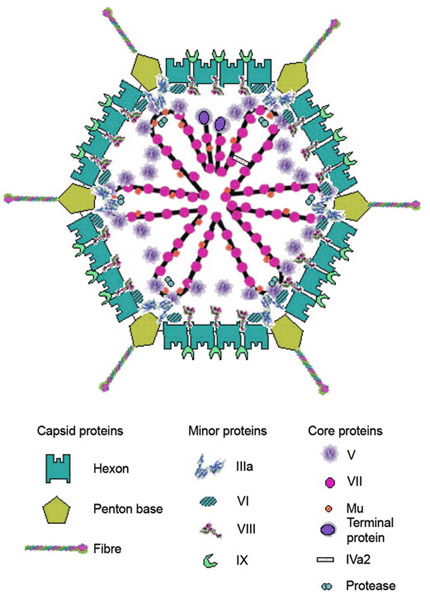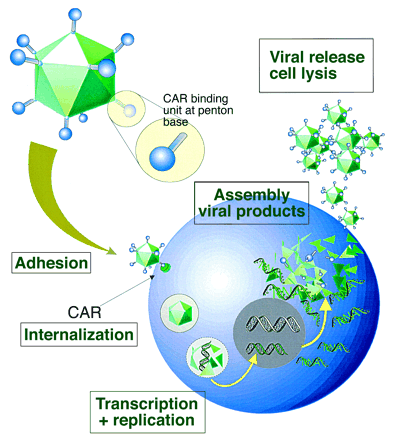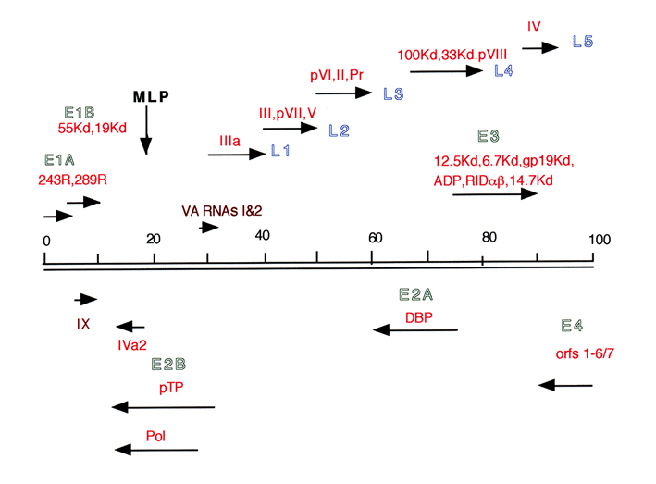Introduction of Adenovirus
New Page 1
The year 1953
saw the isolation of adenovirus, which was soon recognized as an invaluable tool
for investigating mammalian molecular biology. Several of the distinguishing
features of adenovirus have made it the preferred vehicle for gene transfer and
transgene expression in mammalian cells. The following presents a short overview
covering the biology of adenovirus.
Pathology
Adenoviruses are associated with a number of disorders, most of which are
mild. The pathology is primarily from inflammation and loss of infected
epithelial cells. Viruses of subgroup C (serotype 2, 5) cause various
respiration infections in confined groups (elderly, military recruits and
children).
Genome
Adenovirus is a non-enveloped, 80-110 nm diameter virus presenting
icosahedral symmetry. Human adenoviruses contain a linear, double stranded DNA
genome, with a terminal protein (TP) attached covalently to the 5’ termini. The
DNA, which has a length of approximately 36,000 bp, is wrapped in a histone-like
protein and has inverted terminal repeats (ITRs) of 50-200 bp, which act as
origins of replication.
Structure
The hexon, penton base, and knobbed fiber, are the most important capsid
proteins for gene delivery. Hexon is the major protein forming the 20 triangular
faces of the viral capsid. The 240 hexon capsomers in the capsid are trimers,
each interacting with six other trimers. The 12 vertices are formed by the
penton capsomere, a complex of five copies of the penton base, and three copies
of fiber. Each penton capsomere interacts with five hexon capsomeres, one from
each of the five faces that converge at the vertex. The knobbed fiber protrudes
from the fiber base.

Figure 1: Adenovirus Morphology
Adsorption and entry into the cell
The adsorption of the virus to target cell receptors involves high-affinity
binding via the knob portion of the fibre. The prime receptor for human
adenovirus is identical to that for coxsackie B virus and has been named the
coxsackie/adenovirus receptor (CAR). After the attachment step, interaction
between the penton base and
 v
integrins on the cell surface leads to internalisation of the virus through
endocytosis. Once inside the cell, and with help from the penton base, the virus
escapes the endosome and translocates to the nuclear pore complex, where the
viral DNA is released into the nucleus and transcription begins. Transcription,
replication and viral packaging take place in the nucleus of the infected cell.
v
integrins on the cell surface leads to internalisation of the virus through
endocytosis. Once inside the cell, and with help from the penton base, the virus
escapes the endosome and translocates to the nuclear pore complex, where the
viral DNA is released into the nucleus and transcription begins. Transcription,
replication and viral packaging take place in the nucleus of the infected cell.

Figure 2. Infection
process of adenovirus
Transcription
A complex series of splicing accompanies transcription, and genes are
transcribed from both strands. Adenovirus transcription is a two-phase event,
early and late, occurring before and after viral DNA replication, respectively.
The early transcribed regions are E1, E2, E3 and E4. The E1 gene products can be
further subdivided into E1A and E1B. E1 gene products are involved in the
replication of the virus. To insure replication deficiency of the virus used as
gene delivery tool, and therefore to prevent cell lysis, first generation
recombinant adenoviruses are E1 deleted. Once packaged into a complementing cell
line, i.e. a cell line that provides the E1 products in trans (e.g.
QBI-HEK 293A Cells), viral replication will be enabled.

Figure 3. Transcription of the
adenovirus genome
The E2 region is subdivided into E2A and E2B. These proteins provide the
machinery for viral DNA replication and the ensuing transcription of late genes.
Most of the E3 proteins are involved in modulating the immune response of
infected cells, a function not essential for viral growth in vitro.
Therefore, in addition to being E1 deleted, the first generation adenoviruses
are most often E3 deleted ( E1/E3).
E1/E3).
The gene products encoded by the E4 region (called ORFs 1-6/7) are involved in
the metabolism of virus messenger RNA and provide functions that promote virus
DNA replication and shut-off of host protein synthesis. Furthermore, E4 products
prevent viral DNA concatenation.
SignaGen Laboratories offers standard and custom
adenovirus production and amplification services to fit your different research
needs. To learn more about our custom adenovirus production services, please
visit
http://signagen.com/index.php?main_page=index&cPath=146



